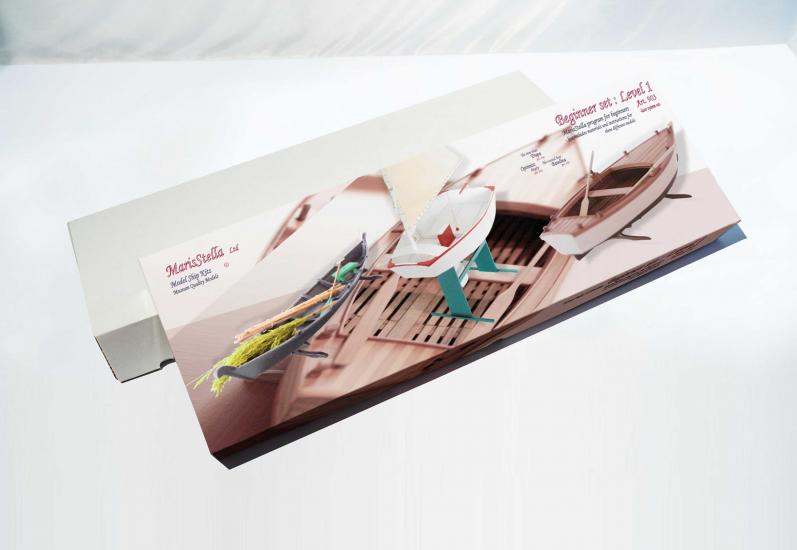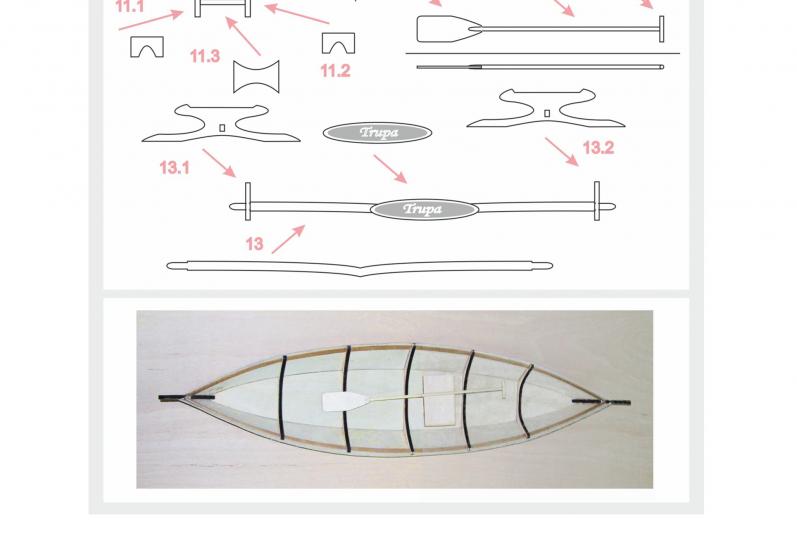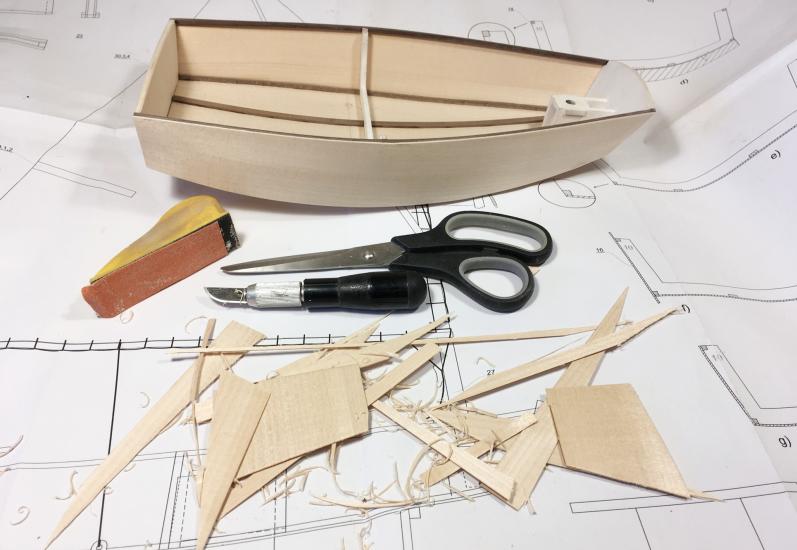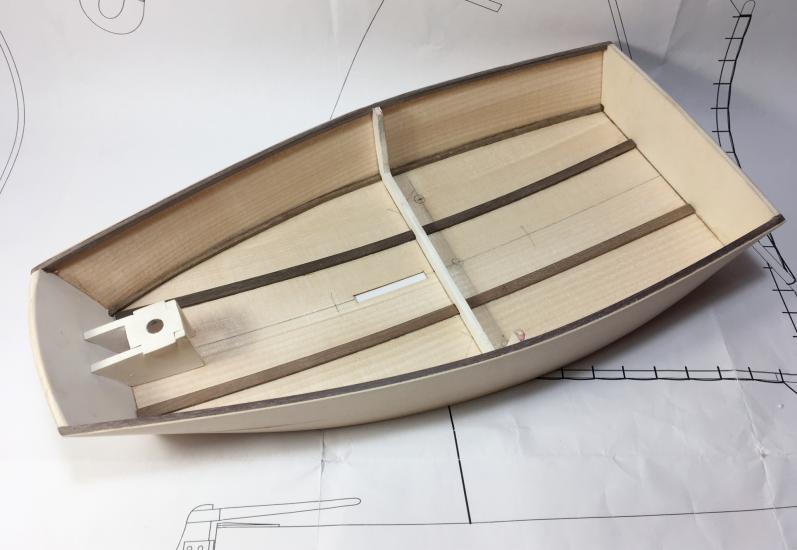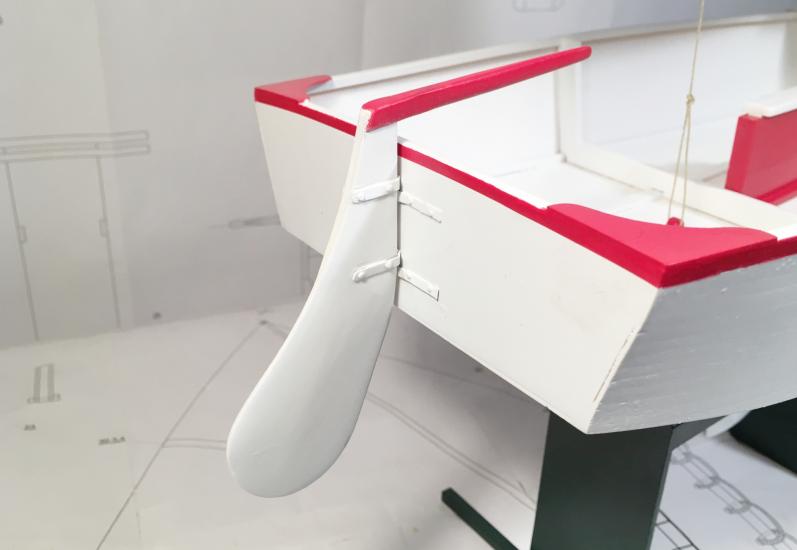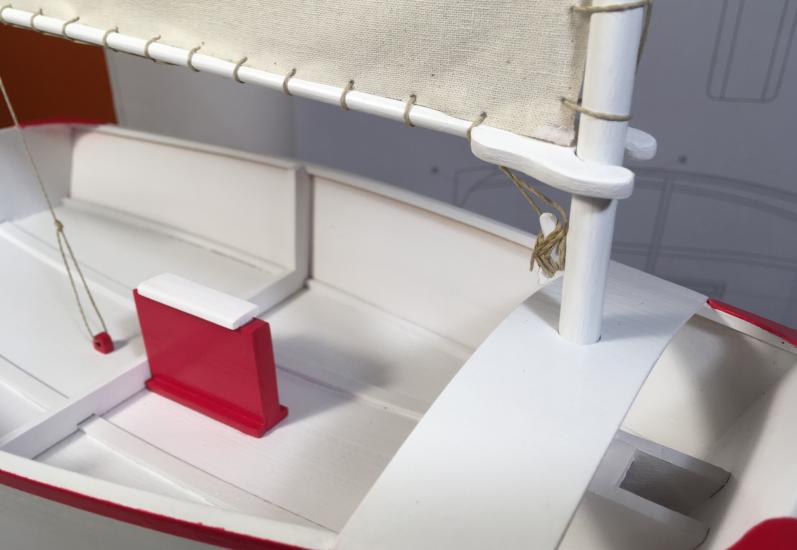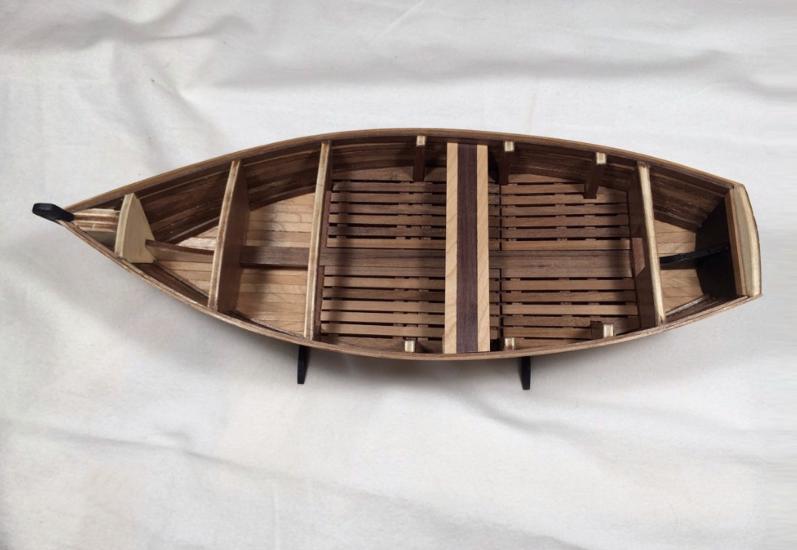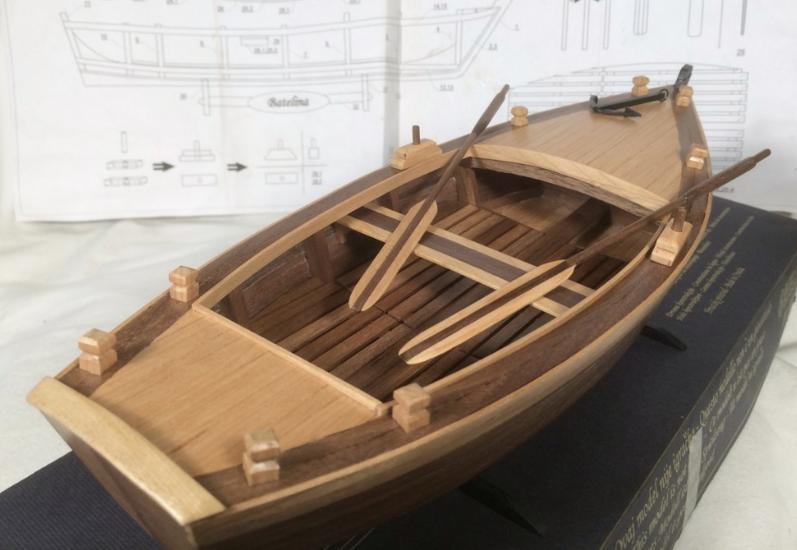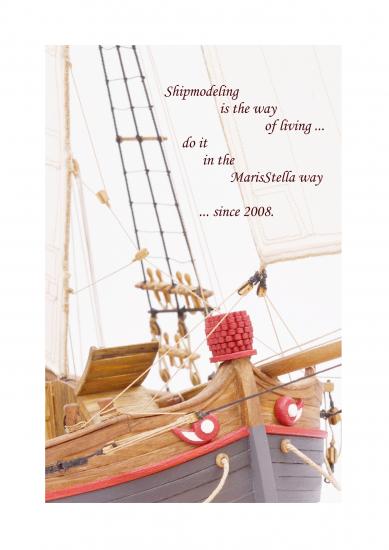Do you like the idea of building ships and boats in wood? Maybe you haven't tried this hobby yet? We have prepared our ''Beginner set: Level 1'', just for you! This is a unique school of ship modeling written in three languages: English, Italian and Croatian. You will master the basics in detail and prepare for the more challenging tasks you will encounter. The school takes you through three boat models: Trupa from the river Neretva, Optimist dinghy, and Batelina from the Adriatic coast. We created this course in 2008, and it has so far met with extremely good results!
At the beginning of the existing MarisStella Model Ship range, we created our first projects: beginner kits Trupa (simple trunk), Monotype Optimist, and Batelina. We created our beginner ship model course out of these three kits and we were very satisfied with the results, as were our customers. Model ship novices were enjoying building these models with a great of satisfaction and success. These ship (boat) models are connected within our story, each one being an advancement on the previous, in terms of skills.
Other ship model kits that we later created, comprising parts of MarisStella’s Model Ship Line, also form a part of our learning school, the course, with full documentation, enabling the modeler to learn and improve his/her skills as they undertake each model as a challenge. Our aim is that our school can help the modeler to progress through our kit projects as they become more adept at the hobby.
All MarisStella kits are designed so they are user-friendly, and we aim that with each, that the modeller will stand the very best chance of having a successful and rewarding result.
When you try ship modeling for the very first time, the Trupa (‘’trunk’’) is exactly what you need. Her simplicity is the guarantee for a successful first build. Her bottom is flat, made of single piece of veneer on this model. In reality she has a flat bottom that is composed of three boards, but this was simplified here so that it stays at very easy level which is suitable for a complete novice.
The bottom of Trupa is bent into its proper shape by the use of two thick beams and fastened to the solid wood base.
Five frames are then easily fixed to the bottom of Trupa. The modeller then fixes the sides of the vessel to the frames and bottom. Here is the how the model is first bevelled…
There are railings to be set onto their graves on the top of the frames and there is Trupa almost completed…
The sides of this boat are each made from a single piece of veneer. They are to be glued onto the construction. After this, the side planking has to be carefully cut into shape…
The Trupa is complete after painting as described in the instructions. This is a process that is very enjoyable and will be mastered by every good ship modeller…
After the simple Trupa, Optimist is a perfect choice to upgrade your skills and newly acquired knowledge…
The ship modeller now progresses through our curriculum. This is a flat bottom fastened to a two-beam-mold, frames and side planks… With the Trupa previously completed, Optimist should further provide some great fun and enjoyment…
A rudder is to be composed out of a few more elements, and hinges are to be set on the transom of this beautiful dinghy. She has a simple bow deck that has to be shaped by bending.
Here is your first encounter with a mast, boom and simple sprit. Dowels have to be cut and shaped…
A simple sailing vessel is a completely new experience. With fabric, you will create the Optimist’s large sail…
As with Trupa, this model will be complete after you have painted it and set it onto its decorative stand.
The last one of three beginners’ models in this course is Batelina; a boat from the Adriatic coast. This boat is built again and again by experienced modellers, because of her sheer beauty and simplicity.
Here is a frame construction, sat on an ordinary keel. The stern ends with a flat transom, having no rudder…
Planking with strips is definitely an experience that every beginner needs to have. The hull is planked with wooden strips. This is done very easily because this model is designed so that planking is straightforward. The completed planking will look beautiful once finished…
Shaping the first oars is the next challenge…
Progressing to Batelina by first completing the two previous models, will encourage the ship model beginner to build more beautiful and complex wooden ship models. As previously mentioned, MarisStella has your next step within its Model Ship Kit range. All you need to do is to further challenge yourself…
Modeling the Trupa, a brief overview
Neretvanska Trupa, boat from the river Neretva,
scale 1/8 19.69'' 50cm
Brief history of the 'Trupa'
For hundreds of years, until the early 1970s, the 'Trupa' was the basic "personal" means of transportation of the Neretva River Delta (Valley), unlike ships which whose main means was the transportation of cargo.
The name derives from the original form when they were simple hollowed „logs" (trunks), similar to many vessels around the world. Along the Croatian coast formerly known as the 'copula'. ('Trupa' means 'a log' or 'a trunk.')
The structure of the 'Trupa'
'Trupa', or 'Trupica' are about 4 meters long and about 0. 60 meter wide, with a flat bottom, made of tarred wooden planks. They serve the farmers of the Neretva delta to go to their fields surrounded by numerous marshy channels and backwaters of the Neretva. They use the 'Trupa' for the transportation of smaller loads. In order to protect them from the sun, in the summer months, they would put hay on her bottom. 'Trupa' is a lightweight boat, easily transported by two people. She is run with the use of one oar while standing, and alternating the rowing from side to side. On rare occasions she may have had a small sail on her bow which would have been square or trapezoid.
Local farmers still use ships and these boats for the transportation of products throughout the valley, the channels and to the marketplaces by the Neretva River.
Modeling the Monotype Optimist, a brief overview
Optimist Dinghy
scale 1/6 15.35'' 39cm
Brief history of the 'Optimist'
There is nothing new to say about the Optimist, except things that have already been said and written in many sources. All I can do is to repeat the facts already known...
This is a small, single-handed dinghy with a sail intended to be used by children under the age of 16. The Optimist is usually made of fiberglass these days, but wood is still used to build them.
This is the one of the most popular sailing dinghies in the world. There are over then 150,000 boats officially registered with the class. There are many more built but never registered.
The Optimist is recognized as an International Class by the International Sailing Federation.
Clark Mills, American, designed the first Optimist in 1947 at the request of the Clearwater Florida Optimist service club. He was following a proposal by Major Clifford McKay to offer low-cost sailing for young people. A simple pram he designed could be built from three sheets of plywood. Clark Mills donated the plan to the Optimists. The design was slightly modified and introduced to Europe by the Dane, Axel Damgaard, and spread across Europe, starting in Scandinavia. This design was standardized in 1960 and became a strict One-Design in 1995.
The Optimist is presently in over than 120 countries and it is one of only two yachts approved by the International Sailing Federation exclusively for sailors under 16.
The structure of the 'Optimist'
The Optimist has a shallow-draught flat-bottomed (pram) hull, originally formed primarily from five pieces of plywood. Just in front of a bulkhead, in the approximate middle of the boat, is the dagger board case. Right behind it on the centerline of the hull floor is attached a pulley and ratchet block. These anchor the rope on the boom directly above. There is a thwart at the bow to support the mast which passes through a hole in its center then to a mast step located underneath the thwart. The rope used for securing a boat is usually tied around the mast step.
The rudder and dagger board could be made from plywood or a composite of foam, fiber glass and epoxy.
The Optimist has the single sail and it is sprit-rigged. The sail has two battens that stiffen the leech. It is secured evenly with ties along the luff to the mast and along the foot to the boom, pulled down tightly by a vang (kicker). There is the light slim third spar, the sprit, which extends through a loop at the seal’s peak. Its bottom rests in the eye of a short string which hangs along the front edge of the mast. Raising and lowering the sprit and adjusting the boom vang allow for adaptation of sail trim to a range of wind conditions. Similarly, the Optimist has a small string outhaul on the end of the boom. It is usually correct to tighten the boom vang, outhaul, and sprit in heavy winds and loosen them in light winds. As well as this, huge adjustments can be made to sail shape, due to all of the ties running along the mast and boom.
The spars are made of aluminum or wood.
There is a monograph-style "IO" insignia (after IODA - the International Optimist Dinghy Association) on the sail and it is a registered trade-mark and may only be used under license from the International Optimist Association. Optimists also have a national sail number using the Olympic abbreviation of their country and a sequential numbers. e.g. USA for United States of America.
In recent years over 3,000 boats a year have been produced by around 30 builders worldwide.
Modeling the Batelina, a brief overview
Croatian coastal region boat
scale 1/10 13.39'' 34cm
This third step in the Beginners’ modelling school is a little more complex and will teach you even more skills to use in future builds. Some of these being your first introduction to a keel and bulkheads, planking a hull and constructing a grated floor.
As in all builds relax, take your time and enjoy...
A brief history and description:
The names Batana and Batelina are derived from the Italian word “battere” which means to hit, this was describing the sound of the flat bottomed boat hitting the waves.
Other sources claim the name derives from the ancient maritime name “batto” which was a small 14th century boat, the Anglo Saxon’s used the name “bat” then finally the English word “boat” came to be.
This vessel is now found throughout the entire Croatian coastal region and has undergone several evolutionary changes. The present day small boat, about 4meters long (approx. 1:3 length-width and about 0,5m high), is now used locally as a fishing vessel, it is the result of a combination of changes taken from the Istrian Batana and the original Batelina. The kit is based on this mixture of characteristics of the Batelina and Batana.
The 4 meter long Batelina is exclusively a flat bottomed boat which has a slight rise at the bow and stern. She has a flat angled stem post and a curved transom rail. Her sides are flat and flared outwards give way to a beautiful line throughout her length. On the rails are 8 bits, four aft and four at the bow also a thole pin on either side. The bow and stern are enclosed giving way to storage and the floor is grated, her single thwart (seat) is located the middle of the boat. Her source of propulsion is two oars with no sails.
Thank you Donald, the materials are great.
To the shop gallery, Model Ship Kits MarisStella:
Beginner set: Level 1
Neretvanska Trupa (boat from the river Neretva) 19.69'' 50cm 1/8
Optimist Dinghy 15.35'' 39cm 1/6
Batelina 13.39'' 34cm 1/10


